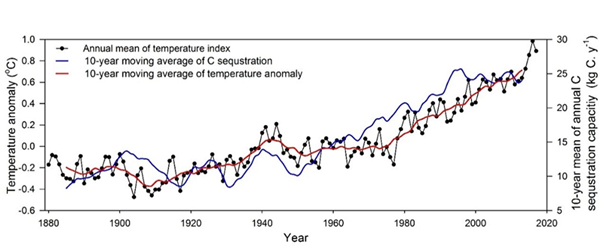Study Reveals the Climatic Driver for Increasing Carbon Sequestration Capacity of Picea schrenkiana in the Tianshan Mountains, China
2021-08-11
The Tianshan Mountains is the largest mountain system in arid area in the world. The Picea schrenkiana (hereinafter abbreviated as P. schrenkiana) forest is currently the most dominant and widespread boreal forest in the Tianshan Mountains. It is also one of the most important zonal forms of vegetation in the Tianshan Mountains in northwestern China.
Changes of carbon sequestration potential capacity in P. schrenkiana forest play a critical role in carbon storage and the carbon cycle in the Tianshan Mountains.
Abundant literature has investigated the static geographical patterns, biomass, NPP, and carbon sequestration of P. schrenkiana forest in the Tianshan Mountains, although over a relatively short time period. To date, however, few studies have analyzed dynamic changes of carbon sequestration potential capacity in aboveground biomass of P. schrenkiana forest in more than five decades in the Tianshan Mountains. In particular, there is a paucity of research on the impact of long-term global climate change on forest carbon sequestration potential capacity in aboveground biomass of P. schrenkiana forest in the Tianshan Mountains.
Researchers from Xinjiang Institute of Ecology and Geography, Chinese Academy of Sciences, reconstructed dynamic change of carbon sequestration capacity in aboveground biomass of P. schrenkiana in the Tianshan Mountains, northwestern China, from 1850–2017 using dendrochronology, and investigated the main climate drivers that affected carbon sequestration capacity.
The results showed that Although the annual carbon sequestration potential capacity in aboveground biomass of P. schrenkiana in 1850–1880 decreased at a rate of 0.29 kg C.y-1, it exhibited an increasing tendency from 1881–2017 at a rate of 0.13 kg C.y-1. During the 70 years from 1881–1950, the annual carbon sequestration potential capacity increased relatively slowly at a rate of 0.03 kg C.y-1. However, it increased rapidly from 1951–2017 with a rate of 0.21 kg C.y-1 .
Temperature, especially minimum temperature, constituted the key climatic driver resulting in increased carbon sequestration capacity. The contribution rates of temperature and minimum temperature to the change of P. schrenkiana carbon sequestration capacity was 75% and 44%, respectively. The significant increase of winter temperature and minimum temperature led to warming in the Tianshan Mountains, resulting in a significant increase in carbon sequestration capacity of P. schrenkiana.
The results indicate that, with the continuous increase of winter temperature and minimum temperature, carbon sequestration of P. schrenkiana in the Tianshan Mountains is predicted to increase markedly in the future.
The findings of this study provide a useful basis to evaluate future aboveground carbon storage and carbon cycles in mountain systems possessed similar characteristics of the Tianshan Mountains.
The results of the study titled "Warming Increases the Carbon Sequestration Capacity of Picea schrenkiana in the Tianshan Mountains, China" was published in Forests.
Article link: https://www.mdpi.com/1999-4907/12/8/1066/pdf

Fig. 1 Change trends of carbon sequestration potential capacity in aboveground biomass of P. schrenkiana from different periods((A)1850–01880; (B) 1881–2017; (C) 1881–1950; (D) 1951–2017) in the Tianshan Mountains. (C sequestration potential: carbon sequestration potential capacity).

Fig. 2 Relationship between global land-ocean temperature index and carbon sequestration capacity in aboveground biomass of P. schrenkiana in the Tianshan Mountains (global annual average temperature anomaly obtained from NASA GISS).

Normalized importance of climatic variables affecting carbon sequestration in ABM of P. schrenkiana in the Tianshan Mountains.
Contact: LIU Jie, Xinjiang Institute of Ecology and Geography
E-mail: liujie@ms.xjb.ac.cn



